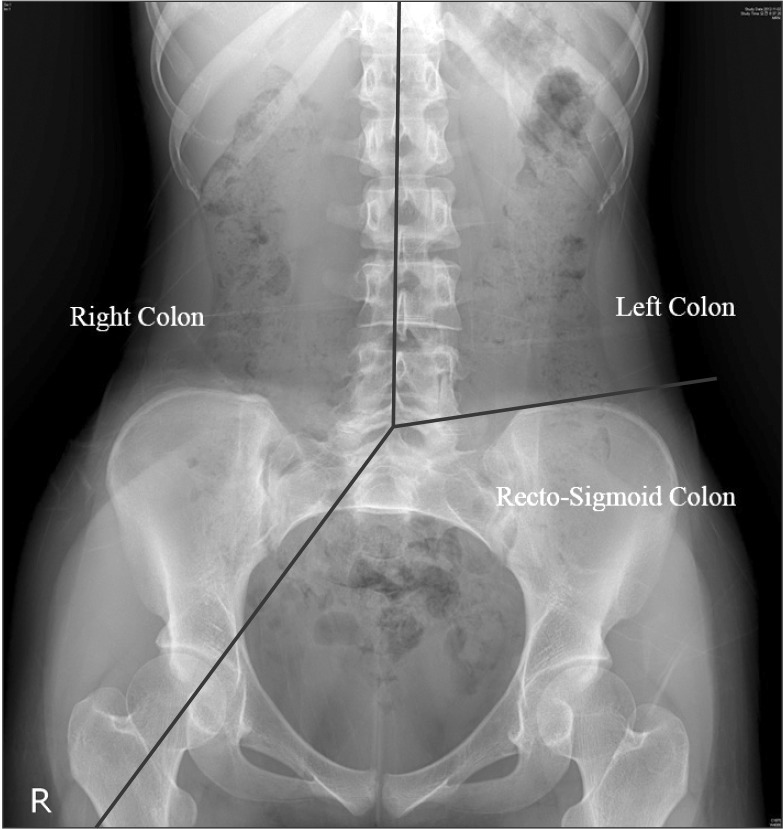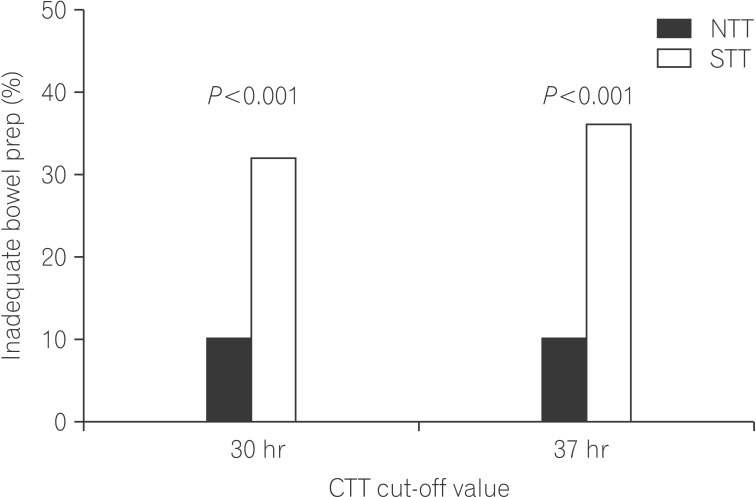Intest Res.
2015 Oct;13(4):339-345. 10.5217/ir.2015.13.4.339.
Colon Transit Time May Predict Inadequate Bowel Preparation in Patients With Chronic Constipation
- Affiliations
-
- 1Department of Internal Medicine, Yonsei University Wonju College of Medicine, Wonju, Korea. hyskim@yonsei.ac.kr
- KMID: 2070750
- DOI: http://doi.org/10.5217/ir.2015.13.4.339
Abstract
- BACKGROUND/AIMS
We evaluated whether colonic transit time (CTT) can predict the degree of bowel preparation in patients with chronic constipation undergoing scheduled colonoscopy in order to assist in the development of better bowel preparation strategies for these patients.
METHODS
We analyzed the records of 160 patients with chronic constipation from March 2007 to November 2012. We enrolled patients who had undergone a CTT test followed by colonoscopy. We defined patients with a CTT > or =30 hours as the slow transit time (STT) group, and patients with a CTT <30 hours as the normal transit time (NTT) group. Boston Bowel Preparation Scale (BBPS) scores were compared between the STT and NTT groups.
RESULTS
Of 160 patients with chronic constipation, 82 (51%) were included in the STT group and 78 (49%) were included in the NTT group. Patients with a BBPS score of <6 were more prevalent in the STT group than in the NTT group (31.7% vs. 10.3%, P=0.001). Multivariate analysis showed that slow CTT was an independent predictor of inadequate bowel preparation (odds ratio, 0.261; 95% confidence interval, 0.107-0.634; P=0.003). The best CTT cut-off value for predicting inadequate bowel preparation in patients with chronic constipation was 37 hours, as determined by receiver operator characteristic (ROC) curve analysis (area under the ROC curve: 0.676, specificity: 0.735, sensitivity: 0.643).
CONCLUSIONS
Patients with chronic constipation and a CTT >30 hours were at risk for inadequate bowel preparation. CTT measured prior to colonoscopy could be useful for developing individualized strategies for bowel preparation in patients with slow CTT, as these patients are likely to have inadequate bowel preparation.
MeSH Terms
Figure
Reference
-
1. Walsh JM, Terdiman JP. Colorectal cancer screening: scientific review. JAMA. 2003; 289:1288–1296. PMID: 12633191.2. Imperiale TF, Wagner DR, Lin CY, Larkin GN, Rogge JD, Ransohoff DF. Risk of advanced proximal neoplasms in asymptomatic adults according to the distal colorectal findings. N Engl J Med. 2000; 343:169–174. PMID: 10900275.3. Burnand B, Bochud M, Froehlich F, Dubois RW, Vader JP, Gonvers JJ. 14. Appropriateness of colonoscopy: screening for colorectal cancer in asymptomatic individuals. Endoscopy. 1999; 31:673–683. PMID: 10571142.4. Cha JM. Colonoscopy quality is the answer for the emerging issue of interval cancer. Intest Res. 2014; 12:110–116. PMID: 25349577.5. Ell C, Fischbach W, Keller R, et al. A randomized, blinded, prospective trial to compare the safety and efficacy of three bowel-cleansing solutions for colonoscopy (HSG-01*). Endoscopy. 2003; 35:300–304. PMID: 12664385.6. Harewood GC, Sharma VK, de Garmo P. Impact of colonoscopy preparation quality on detection of suspected colonic neoplasia. Gastrointest Endosc. 2003; 58:76–79. PMID: 12838225.7. Cohen SM, Wexner SD, Binderow SR, et al. Prospective, randomized, endoscopic-blinded trial comparing precolonoscopy bowel cleansing methods. Dis Colon Rectum. 1994; 37:689–696. PMID: 8026236.
Article8. Ness RM, Manam R, Hoen H, Chalasani N. Predictors of inadequate bowel preparation for colonoscopy. Am J Gastroenterol. 2001; 96:1797–1802. PMID: 11419832.9. Kim WH, Cho YJ, Park JY, Min PK, Kang JK, Park IS. Factors affecting insertion time and patient discomfort during colonoscopy. Gastrointest Endosc. 2000; 52:600–605. PMID: 11060182.10. Hassan C, Fuccio L, Bruno M, et al. A predictive model identifies patients most likely to have inadequate bowel preparation for colonoscopy. Clin Gastroenterol Hepatol. 2012; 10:501–506. PMID: 22239959.11. Chung YW, Han DS, Park KH, et al. Patient factors predictive of inadequate bowel preparation using polyethylene glycol: a prospective study in Korea. J Clin Gastroenterol. 2009; 43:448–452. PMID: 18978506.
Article12. Jun DW, Park HY, Lee OY, et al. A population-based study on bowel habits in a Korean community: prevalence of functional constipation and self-reported constipation. Dig Dis Sci. 2006; 51:1471–1477. PMID: 16832618.13. Fatima H, Johnson CS, Rex DK. Patients' description of rectal effluent and quality of bowel preparation at colonoscopy. Gastrointest Endosc. 2010; 71:1244–1252.e2. PMID: 20362286.14. Cho KO, Jo YJ, Song BK, Oh JW, Kim YS. Colon transit time according to physical activity and characteristics in South Korean adults. World J Gastroenterol. 2013; 19:550–555. PMID: 23382635.15. Meir R, Beglinger C, Dederding JP, et al. Age- and sex-specific standard values of colonic transit time in healthy subjects. Schweiz Med Wochenschr. 1992; 122:940–943. PMID: 1615304.16. Longstreth GF, Thompson WG, Chey WD, Houghton LA, Mearin F, Spiller RC. Functional bowel disorders. Gastroenterology. 2006; 130:1480–1491. PMID: 16678561.17. Arhan P, Devroede G, Jehannin B, et al. Segmental colonic transit time. Dis Colon Rectum. 1981; 24:625–629. PMID: 7318630.
Article18. Froehlich F, Wietlisbach V, Gonvers JJ, Burnand B, Vader JP. Impact of colonic cleansing on quality and diagnostic yield of colonoscopy: the European Panel of Appropriateness of Gastrointestinal Endoscopy European multicenter study. Gastrointest Endosc. 2005; 61:378–384. PMID: 15758907.
Article19. Jung HK, Kim DY, Moon IH. Effects of gender and menstrual cycle on colonic transit time in healthy subjects. Korean J Intern Med. 2003; 18:181–186. PMID: 14619388.
Article20. Lai EJ, Calderwood AH, Doros G, Fix OK, Jacobson BC. The Boston bowel preparation scale: a valid and reliable instrument for colonoscopy-oriented research. Gastrointest Endosc. 2009; 69:620–625. PMID: 19136102.
Article21. Rex DK, Imperiale TF, Latinovich DR, Bratcher LL. Impact of bowel preparation on efficiency and cost of colonoscopy. Am J Gastroenterol. 2002; 97:1696–1700. PMID: 12135020.
Article22. Kang MS, Kim TO, Seo EH, et al. Comparison of the efficacy and tolerability between same-day picosulfate and split-dose polyethylene glycol bowel preparation for afternoon colonoscopy: a prospective, randomized, investigator-blinded trial. Intest Res. 2014; 12:53–59. PMID: 25349564.
Article23. Kim ER, Rhee PL. How to interpret a functional or motility test -colon transit study. J Neurogastroenterol Motil. 2012; 18:94–99. PMID: 22323993.
Article24. Shin EK, Park SJ, Kim KJ, et al. Effect of combination pretreatment of polyethylene glycol solution and magnesium hydroxide for colonoscopy. Korean J Gastroenterol. 2010; 55:232–236. PMID: 20389176.
Article
- Full Text Links
- Actions
-
Cited
- CITED
-
- Close
- Share
- Similar articles
-
- Relevance of Colonic Gas Analysis and Transit Study in Patients With Chronic Constipation
- Colonic Transit Time in Chronic Constipated Patients
- Clinical Significance of Colon Transit Time Study in Patients with Chronic Constipation
- Colon Transit Time and Management of Upper Motor Neuron Type Neurogenic Bowel in Spinal Cord Injury
- Predictors of Inadequate Bowel Preparation and Salvage Options on Colonoscopy




